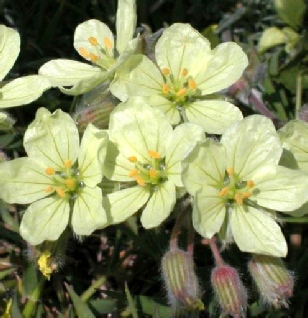Erodium
and California
This site was created and is maintained by Benjamin Coultrup.
Photos all ©Benjamin Coultrup unless otherwise indicated, 1984-
Clade I, Subclade 1
Subgenus Erodium
Clade I, Subclade 2
Subgenus Barbata
Clade II, Subclade 3
Clade II, Subclade 4
-
-
Erodium somanum Peșmen
Clade I; Subclade 2; Section Absinthoidea
A dioecious perennial similar to E. sibthorpianum and E. absinthoides. Plants are wide hard hummocks, up to 60cm across, with a black woody taproot.
Leaves bipinnatisect, oblong-
Inflorescence: Flowering stems are erect to 20 cm, with 2-

Distribution: endemic to Western Turkey in rocky habitats, above 800m, in the Güllük Mountains in Soma, Manisa, critically endangered.
E. sibthorpianum differs in having lilac flowers, leaves less canescent, and a shorter beak, E absinthoides has lax rosettes, white flowers and a longer sepal mucro.
Erodium somanum